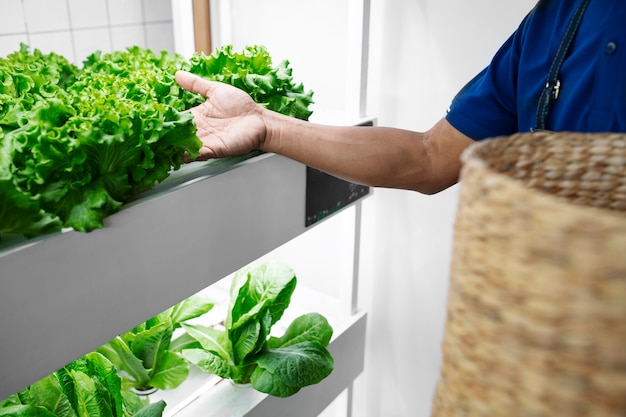This article explores advancements and strategies in urban farming designed to maximize food production while minimizing environmental impact and resource consumption. It examines various techniques, technologies, and socio-economic considerations contributing to the rise of sustainable urban agriculture as a crucial element of resilient and eco-conscious city planning.
Vertical Farming: Reaching New Heights in Food Production

Vertical farming utilizes stacked layers to cultivate crops in a controlled environment. This approach significantly increases yield per unit area, reducing land requirements often scarce in urban environments. Several key facets contribute to the success of vertical farming systems:
- Controlled Environment Agriculture (CEA): Precise control over temperature, humidity, light, and nutrient delivery optimizes plant growth and minimizes resource waste.
- Hydroponics and Aeroponics: Soil-less cultivation techniques, using nutrient-rich water or air, minimize water usage and nutrient runoff, contributing to sustainability.
- Automation and Technology: Automated systems for irrigation, climate control, and harvesting enhance efficiency and reduce labor costs.
- Challenges and Considerations: High initial investment costs, energy consumption, and potential technical difficulties present obstacles to widespread adoption.
Urban Rooftop Gardens: Utilizing Unused Spaces

Rooftop gardens transform underutilized spaces into productive agricultural areas. This approach offers several benefits:
- Increased Green Space: Creating green spaces in urban areas improves air quality, reduces the urban heat island effect, and enhances the aesthetic appeal of buildings.
- Reduced Carbon Footprint: Locally grown produce reduces transportation emissions associated with food distribution.
- Community Engagement: Rooftop gardens can serve as community hubs, fostering social interaction and promoting environmental awareness.
- Structural Considerations: Weight limitations, waterproofing, and drainage systems need careful consideration to ensure structural integrity and prevent damage.
Community Gardens: Fostering Collaboration and Food Security
Community gardens provide shared spaces for residents to cultivate food, fostering a sense of community and improving access to fresh produce. Key aspects include:
- Social Cohesion: Community gardens bring people together, fostering collaboration and a sense of shared responsibility.
- Food Security: Increased access to nutritious food enhances community health and well-being, particularly in food deserts.
- Educational Opportunities: Community gardens provide opportunities for education and skill-building related to sustainable agriculture.
- Management and Sustainability: Effective community engagement, resource management, and conflict resolution are crucial for long-term success.
Aquaponics: A Symbiotic Approach to Sustainable Food Production
Aquaponics integrates aquaculture (fish farming) and hydroponics, creating a closed-loop system where fish waste provides nutrients for plants, and plants filter the water for the fish. This approach:
- Reduces Water Consumption: Water is recirculated within the system, significantly reducing water usage compared to traditional agriculture.
- Minimizes Waste: Fish waste is utilized as fertilizer, reducing waste and enhancing nutrient cycling.
- Enhanced Food Production: Simultaneous production of fish and plants increases overall food yield per unit area.
- Technical Expertise: Requires specialized knowledge and careful management to maintain the delicate balance within the system.
Technological Advancements: Driving Innovation in Urban Farming
Technological advancements are revolutionizing urban farming practices, leading to greater efficiency and sustainability. These include:
Read Also: Explore Northern Greece: Your Guide to Greek Macedonia
- Precision Agriculture Technologies: Sensors and data analytics optimize resource utilization and improve crop yields.
- AI-powered Systems: Artificial intelligence optimizes environmental control, pest management, and harvesting processes.
- Robotics and Automation: Robotics and automation reduce labor costs and enhance efficiency in tasks like planting, harvesting, and weeding.
- Accessibility and Affordability: Ensuring access to these technologies for small-scale urban farms is crucial for equitable adoption.
Policy and Infrastructure: Supporting the Growth of Urban Farming
Supportive policies and infrastructure are crucial for the development of sustainable urban farming initiatives. These aspects include:
- Zoning Regulations: Relaxing zoning restrictions to allow for urban farming in various locations.
- Financial Incentives: Providing grants, tax breaks, and subsidies to support urban farming projects.
- Infrastructure Development: Investing in infrastructure such as water management systems and waste processing facilities.
- Community Engagement: Involving communities in the planning and implementation of urban farming initiatives ensures their long-term success and community buy-in.
The Future of Sustainable Urban Farming: A Vision for Resilient Cities
Sustainable urban farming is poised to play a pivotal role in creating resilient and environmentally conscious cities. Further research and development, along with supportive policies and community engagement, will be essential to realize the full potential of this crucial sector. The future may hold even more innovative solutions, including:
- Advanced vertical farming techniques: Further optimization of CEA and the development of more efficient and cost-effective systems.
- Integration of renewable energy sources: Reducing reliance on fossil fuels through the integration of solar, wind, or geothermal energy.
- Closed-loop systems: Minimizing waste and resource consumption through the development of more efficient closed-loop systems.
- Global Collaboration: Sharing best practices and research findings across different urban settings to accelerate progress and innovation.

